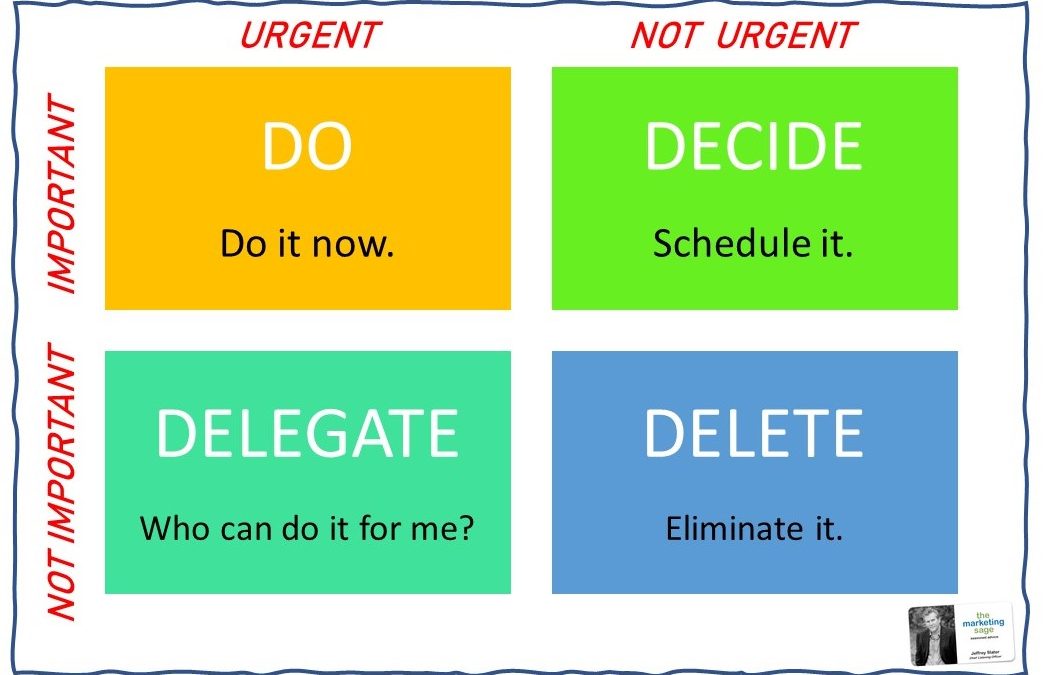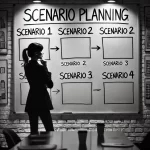The Eisenhower Matrix
Do you freeze up when you begin your day with so much to do? Are you unsure what’s truly important?
President Eisenhower used a simple grid that helped him make decisions when he was a General and The President of The United States. Imagine his inbox?
His grid is brilliantly simple. Clear. And needs little explanation. But for those who want a little guide to follow – here goes.
Eisenhower matrix categories
Using the Eisenhower matrix, you divide your responsibilities into four different categories:
- Urgent and important: These are the tasks you will immediately work on.
- Important but not urgent: These tasks are essential but can be scheduled later.
- Urgent but not important: These tasks must be completed immediately but aren’t overly critical and can be delegated to someone else.
- Not urgent or important: These tasks can be eliminated.
I like to think of these categories as Do, Decide, Delegate & Delete
Urgent V. Import
An urgent task requires immediate attention.
They are time-sensitive and have a hard, fixed deadline. Returning someone’s call may be necessary, but is it urgent? When my boss or an important client needs something from me by noon, it is urgent and needs to get done now.
Important tasks are – well, important, just not as time-sensitive.
If I must present a slide deck summarizing my results from research, I know it is due in 4 weeks. I want to begin to work on it today.
How I use the Eisenhower matrix to stay calm and get stuff done
Everything gets labeled either urgent or important on my to-do list.
Urgent might be preparing for a client meeting that starts at 8 am tomorrow. It rises to the top of the list. While something important, like scheduling a follow-up client call, can wait until this afternoon.
I don’t waste time on anything that isn’t urgent or important.
Once I have completed those tasks or taken them as far as possible, I move on to other stuff.
What do I have to decide on is next on my list.
These are tasks that are important but rarely urgent too. I can schedule them for after the critical is completed. I might decide whether to join a conference call or schedule a follow-up meeting. Perhaps I need to think about it first. But if it can wait, let it sit until I complete the more critical tasks.
The delegate stuff is often things that I can ask others to complete. Perhaps it is a free-lancer or an administrative assistant. If you have a team – maybe someone else should be doing this task, not you. If you can delegate a job, it frees up your time – and it might allow a team member to learn a new skill.
Delete the unnecessary task is perhaps my favorite quadrant of all.
I get to decide if something is even worth anyone’s time. Is it on strategy or a nice to consider, but not that important? Maybe attending a meeting or sitting in on a webinar would be enjoyable or helpful – but it just isn’t that urgent or essential.
It is helpful to limit how many items go into each grid section. Too many things make it challenging to complete. Another consideration is to separate personal from the professional task. I prefer to combine them because it helps remind me what is urgent. A child’s dance recital or softball game may be more critical than a client’s presentation – if you can complete it at night.
Some folks use color-coding or other ways to keep the grid simple and easy to follow. I prefer to get one thing done – or as far as I can take it before moving on to the next task. Multi-tasking doesn’t work for me.
A Final Tip
I find that “heavy lifting” needs to get done in the morning when my concentration is best. I like to put off lightweight things for later in the afternoon when I’m not as tired.
I begin my day with meditation for 15 minutes. Then coffee. And then, I use the Eisenhower grid as a framework for what needs to get done.
I start my day with the urgent and time-sensitive stuff that is hard. The rest of the things to do seem to flow.
P.S. If you haven’t read this post, I also have a DO NOT DO list that I frequently update, so my to-do list isn’t cluttered.
You can set up a time to chat with me about your marketing challenges using my calendar. Email me jeffslater@themarketingsage.com Call me. 919 720 0995. The conversation is free, and we can explore if working together makes sense. Watch a short video about working with me.
Image: The Marketing Sage Consultancy, all rights reserved.





